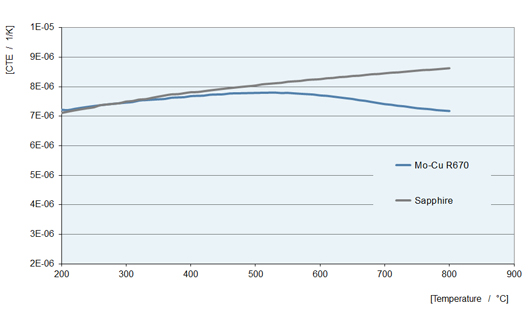- News
6 March 2012
PLANSEE launches MoCu composite wafer substrate to prevent cracks in LED chips
PLANSEE High Performance Materials of Reutte, Austria has developed MoCu R670, a molybdenum-copper composite material for semiconductor wafer substrates which has high thermal conductivity to ensure optimized heat dissipation in LED chips. The new material has the same coefficient of thermal expansion as sapphire, and hence reduces defects in the semiconductor structure that can occur during the hot bonding process. Mo-Cu R670 therefore helps to ensure the reliable production of LED chips and increases the efficiency of the light source, claims the firm.

In the most commonly used process for the production of blue-spectrum chips (including white LEDs), gallium nitride (GaN)-based semiconductor layers are grown on sapphire (Al2O3) substrate using epitaxial growth methods such as metal-organic chemical vapour deposition (MOCVD). A metallic wafer, intended for the dissipation of heat, is then bonded to the semiconductor layers at high temperatures using various joining technologies. However, stresses caused by different coefficients of thermal expansion can lead to cracks in the semiconductor layers. To prevent these defects, the metal wafer substrate ideally has the same coefficient of thermal expansion (CTE) as sapphire.
Molybdenum is commonly used for such wafer substrates, since it offers good thermal conductivity and is very heat-resistant. However, molybdenum has a lower coefficient of thermal expansion than sapphire. PLANSEE hence developed wafer substrates made from the molybdenum-copper composite material R670 especially for sapphire-based and high-temperature-bonded LED chips. R670 has a thermal conductivity of 170W/mK and, with 6.7ppm/K, the same CTE as sapphire.
PLANSEE can supply Mo-Cu wafer substrates with coatings made from nickel-gold, ruthenium, chromium, silver and other interface materials, which protect the wafer substrate against corrosion and optimize its surface properties for the subsequent bonding process.
As a manufacturer of refractory metals and composite materials, PLANSEE supplies metallic wafer substrates for heat dissipation as well as other components for the production of LED chips and packages. These include furnace components and molybdenum and tungsten crucibles for sapphire single-crystal growth, components for MOCVD/MBE reactors, evaporation boats and coils for metallic mirror or barrier layers, and base plates for improved thermal management of high-power LEDs.
